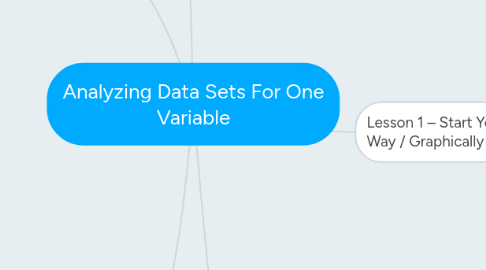
1. Lesson 3: You Are Too Far Away / Calculating IQR and Outliers
1.1. Learning Goals
1.1.1. 3. Calculate Interquartile Range (IQR) and identify outliers
1.2. Student Learning Objective
1.2.1. 1. Calculate and interpret the interquartile range (IQR) of a data set. 2. Determine if a data set contains outliers
1.3. Assessment
1.4. Technology
1.4.1. http://www.alcula.com/calculators/statistics/interquartile-range/
1.5. Teacher/Student Activity
1.5.1. Problem 1 Touchdown
1.5.1.1. Analyze Data Sets
1.5.1.2. Calculate Interquartile Range (IQR)
1.5.2. Problem 2 Get Outta Here!
1.5.2.1. Calculate Outliers Using Box and Whiskers Plot
1.5.3. Problem 3 Hurry Up!
1.5.3.1. Create Box and Whiskers Plot
1.5.3.2. Calculate IQR
1.5.3.3. Calculate Measure of Central Tendency
1.5.3.4. Identify Outliers
1.5.4. Talk the Talk
1.5.4.1. Rationalizing Your Answers
2. Lesson 4: Whose Score Are Better? / Calculating and Interpreting Standard Deviation
2.1. Learning Goals
2.1.1. 4. Calculate and interpret standard deviation
2.2. Student Learning Objective
2.2.1. Calculate and interpret the standard deviation of a data set
2.2.2. Compare the standard deviation of data set
2.3. Assessment
2.4. Technology
2.4.1. Statistics Calculator Using Excel
2.4.2. http://www.mathwarehouse.com/charts/box-and-whisker-plot-maker.php
2.5. Teacher/Student Activity
2.5.1. Problem 1 Spelling Success
2.5.1.1. Determine mean & median
2.5.1.2. Make conclusion
2.5.1.3. Create Box & Whiskers Plot
2.5.1.4. Interpret Test Scores
2.5.1.5. Rationalize
2.5.2. Problem 2 So . . . Who Did Better?
2.5.2.1. Vocabulary-Standard Deviation
2.5.2.2. Standard Deviation Formula
2.5.2.3. Calculate Standard Deviation
2.5.3. Problem 3 Work As a Team
2.5.3.1. Using Dot Plot to Determine Std. Deviation
2.5.3.2. Calculate Std. Deviation
2.5.4. Problem 4 65-95-99: The Combination For Std. Deviation
2.5.4.1. Calculate Std. Deviation 2 & 3
2.5.4.2. Create Bell Curve Graph
2.5.5. Talk the Talk
3. Lesson 5: Putting The Pieces Together / Analyzing and Interpreting Data
3.1. Learning Goals
3.1.1. 5. Analyze and interpret data graphically and numerically.
3.2. Student Learning Objective
3.2.1. Analyze and interpret data graphically and numerically. • Determine which measure of central tendency and spread is most appropriate to describe a data set
3.3. Assessment
3.4. Technology
3.4.1. Statistic Calculator Using Excel
3.5. Teacher/ Student Activity
3.5.1. Problem 1 Go For The Gold
3.5.1.1. Calculate mean and std. deviation
3.5.1.2. Create Box-and- Whiskers Plot
3.5.1.3. interpret IQR
3.5.1.4. Reasoning
3.5.1.5. Conclusion
3.5.2. Problem 2 Flying High
3.5.2.1. What is Stem-Leaf Plot?
3.5.2.2. Using Side By Side Stem Leaf Plot
3.5.2.2.1. Calculate Measure of Central Tendency
3.5.2.2.2. Make Conclusion
3.5.2.2.3. Reasoning
3.5.3. Talk the Talk
3.5.3.1. Analyze Box-and- Whiskers Plot
3.5.3.2. Adding New Value to a Data Set
3.5.3.2.1. How it effects the mean & median?
4. Lesson 1 – Start Your Day Right The Right Way / Graphically Organizing Data
4.1. Student Learning Objectives
4.1.1. Represent and interpret data displayed on dot plot
4.1.2. Represent and interpret data displayed on histogram
4.1.3. Represent and interpret data displayed on box-and-whiskers plot
4.2. Learning Goals
4.2.1. Able to represent data graphically
4.3. Assessment
4.4. Technology
4.4.1. Lesson 8.1 Power Point
4.4.2. http://www.shodor.org/interactivate/activities/Histogram/
4.4.3. http://www.mathwarehouse.com/charts/box-and-whisker-plot-maker.php
4.5. Teacher/ Student Activity
4.5.1. Problem 1 How Much Sugar Is Too Much?
4.5.1.1. Create a Dot Plot Using the Data
4.5.1.2. Vocabulary
4.5.1.2.1. symmetric distribution
4.5.1.2.2. skewed right distribution
4.5.1.2.3. skewed left distribution
4.5.2. Problem 2 Boxing It Up
4.5.2.1. Create a box and Whiskers Plot
4.5.2.1.1. http://www.mathwarehouse.com/charts/box-and-whisker-plot-maker.php
4.5.2.2. The Five Number Summary
4.5.2.2.1. Minimum
4.5.2.2.2. Quartile 1
4.5.2.2.3. Median
4.5.2.2.4. Quartile 3
4.5.2.2.5. Maximum
4.5.3. Problem 3 Weekend Gamers
4.5.3.1. Create a histogram
4.5.3.1.1. http://www.shodor.org/interactivate/activities/Histogram/
4.5.3.2. Talk the talk- Analyzing Data Representation
5. Lesson 2: Which Measure Is Better / Determining The Best Measure of Center of a Data Set
5.1. Problem1 How sweet is it?
5.1.1. Measure of Central Tendency
5.1.1.1. Mean
5.1.1.2. Median
5.2. Problem 2 Does height really matter?
5.2.1. Represent data in dot plot form
5.3. Talk the Talk
5.3.1. Identify the best Measure of Central Tendency
5.4. Learning Goals
5.4.1. 2. Determine the best measure of center of a data set
5.5. Students Learning Objective
5.5.1. Calculate and interpret the mean of a data set.
5.5.2. Calculate and interpret the median of a data set.
5.5.3. Estimate the mean and median of a data set from its data distribution.
5.5.4. Determine which measure of central tendency
5.5.5. (mean or median) is best to use for a data set.
